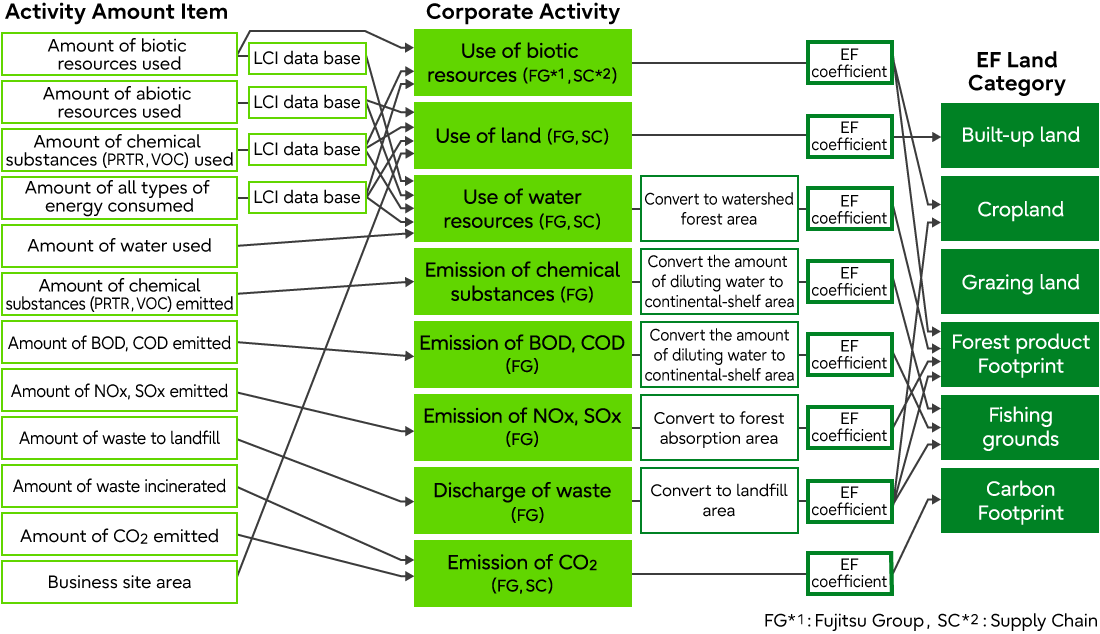TNFD-Based Information Disclosure
1. Introduction
The Fujitsu Group has established Solving global environmental issues (Living in harmony with nature) as one of its essential contributions (Materiality). Our approach to Materiality is to implement measures against risk, focused on internal initiatives within Fujitsu, and to take up opportunities to solve social issues through business expansion, with Fujitsu Uvance. We are committed to achieving Net-Positive by promoting our approach to Materiality and providing value to our customers and society; we will reduce any negative impacts and expand the positive impacts on Fujitsu businesses and society.
Since nature-related issues vary according to location and business, achieving the Fujitsu Group’s vision requires measures based on an understanding of each business and each location. Therefore, in FY2024, the first year of TNFD-based disclosure, the LEAP analysis concepts were employed in the study of nature-related issues in targeted businesses and priority locations.
2. TNFD-Based Information Disclosure
General requirements, and governance, strategy, Risk and impact management, metrics and targets, are shown in the table below.
- Application of materiality
Importance (materiality) was assessed taking into account the extent of nature-related dependencies and impacts, as well as the degree of importance to the business. - Scope of disclosures
(1) Upstream value chain (“supply chain”):The Fujitsu Group has identified for analysis ten types of energy or raw materials (zinc, gold, silver, petroleum, steel, natural gas, copper, nickel, aluminum, coal) as important raw materials for the identification of sensitive locations. Further, it has targeted the information and telecommunications business of Service solutions segment and the manufacturing business of Hardware solutions segment, for analysis to identify important dependencies and impacts, and identify and assess risks and opportunities.
(2) Direct operations: Fujitsu Ltd and Group companies (with 50% or more shareholding) were the target of analysis.
Note that in the identification of priority locations, analysis focused on plants, main data centers, and main development sites and offices (top sites for GHG emissions). To identify important dependencies and impacts, and identify and assess risks and opportunities, the information and telecommunications business of Service solutions segment and the manufacturing business of Hardware solutions segment, were analyzed.
(3) Downstream value chain : Because detailed information is difficult to obtain due to the wide variety of customer industries and application uses, and because customer environmental impacts are difficult to control, these were excluded from analysis. - Location of nature-related issues
For locations within the above scope, sensitive locations were identified using IBAT etc. Material locations were also identified using degree of nature-dependency by ENCORE assessment and environmental performance data at each business site. Locations that were both sensitive locations and material locations were identified as priority locations. - Integration with other sustainability-related disclosures
The Fujitsu Group has implemented TCFD-based information disclosure(*1) . We are now considering future integration of individual disclosures with TCFD-based disclosures. - The time horizons considered
For identification and assessment of risks and opportunities, short-to-medium term is considered as up to 2030, and long-term as up to 2050. - Engagement with Indigenous Peoples, Local Communities and affected stakeholders
Any required engagement with impacted stakeholders such as indigenous people and local communities aligns with the Fujitsu Group Human Rights Statement and the Multi-stakeholder Policy. - *1: TCFD-based information disclosure
- Governance A, B:
Same as TCFD-based information disclosure - Governance C:
Our response with respect to human rights has been implemented in accordance with the Fujitsu Group Human Rights Statement. Stakeholder engagement aligns with our Multi-stakeholder Guidelines.
- Strategy A:
【Dependencies and impacts】
Using ENCORE, a general-purpose nature-related analysis tool, nature-related dependencies and impacts in the supply chain and in direct operations were assessed. It was found that the impact on nature of “emissions of harmful pollutants into water and soil” might be a highly important impact in the supply chain and in direct operations.
【Risks and opportunities】
Any decline in the ecosystem services that Fujitsu’s supply chain might depend on incurs risks to raw materials procurement and operations as well as in the supply of products and services. With societal change as we move towards achievement of a nature-positive society, there might be risks such as response to laws and regulations and reporting guidelines, increased costs of responding to changing customer preferences, and corporate reputational damage due to failure to address natural capital.
As a company with strengths in ICT technology, Fujitsu might have opportunities in the building of sustainable supply chains and increased demand for corporate services, such as use of ICT technology for more efficient ecosystem monitoring and environmental impact measurement. - Strategy B:
For future consideration. - Strategy C:
For future consideration. - Strategy D:
【Priority locations】
(1) Direct operations: Three plants outside Japan have been identified as locations that might have negative impacts on surrounding nature and important ecosystems due to emissions of harmful pollutants into soil and water. The details and existence of negative impacts are to be confirmed, and a decision will be made as to whether it is a priority location in the future.
(2) Supply chain: 582 candidates for sensitive locations were identified through analysis based on general information about ten types of energy and raw materials.
Identification of priority locations was excluded because assessment was general in nature. Future work to identify priority locations is planned through analysis and assessment using primary supplier information that could enable assessment of material locations.
- Risk and impact management A,B,C:
Same as TCFD-based information disclosure
- Metrics and targets A:
For future consideration. - Metrics and targets B:
Ecological Footprint has been selected as the metric for comprehensive assessment of overall corporate activity.
Metrics for priority locations will be considered in future. - Metrics and targets C:
Performance against target will be managed using metrics of comprehensive assessment of overall corporate activity and metrics for priority locations.
FY2030 medium-term targets for overall corporate activity: Reduce negative impacts on biodiversity by at least 25% (Base year : FY2020) in the area of company's corporate activities, including supply chain, and promote activities to increase positive impacts on it. FY2024 results: 28.5% decrease against FY2020 base.
Targets for priority locations are for future consideration.
3. Supplementary Information regarding TNFD-Based Information Disclosure Details
3.1 Scope of disclosure
Target scope
In upstream value chains for raw materials and parts procurement, due to our environmentally friendly goods procurement in accordance with the Fujitsu Group Green Procurement Standards and Ecosystem Performance Guidelines for Suppliers, it has been deemed possible to deal with negative impacts and risks to the environment, and so this has been included in the analysis.
Note however that in the identification of sensitive locations, it is difficult to ensure traceability all the way upstream. Therefore, reference has been made to the SBTN High Impact Commodity List, and ten types of energy and mineral resources (zinc, gold, silver, petroleum, iron, natural gas, copper, nickel, bauxite, coal) that are important raw materials for the Fujitsu Group were analyzed.
Further, in the identification of important dependences and impacts and the identification and assessment of risks and opportunities, the information and telecommunications business of Service solutions segment and the manufacturing business of Hardware solutions segment were analyzed.
* As a result of assessment of nature-related dependencies and impacts and their importance to the business (sales) using ENCORE, the information and telecommunications business of Service solutions segment and the manufacturing business of Hardware solutions segment were identified as priority businesses.
Fujitsu Limited and its Group companies (shareholdings of 50% or more) were the target of analysis.
Note that analysis to identify priority locations focused on plants, the main data centers, and the main development sites and offices (top locations for Greenhouse Gas (GHG) emissions).
Small sites were excluded as their environmental burden was considered low. Size of site is deemed to correlate broadly with GHG emissions, with analysis focused on sites with GHG emissions of 1,000 tons or more. (Covers around 97% of total on an GHG emissions base.)
The information and telecommunications business of Service solutions segment and the manufacturing business of Hardware solutions segment were the focus of analysis to identify important dependencies and impacts and to identify and assess risks and opportunities.
* As a result of assessment of nature-related dependencies and impacts and their importance to the business (sales) using ENCORE, the information and telecommunications business of Service solutions segment and the manufacturing business of Hardware solutions segment were identified as priority businesses.
Because detailed information is difficult to obtain due to the wide variety of customer industries and application uses, and because customer environmental impacts are difficult to control, these were excluded from analysis.
3.2 Assessment of nature-related dependencies and impacts
(1)Linking of business activity into ISIC classifications
All the Fujitsu Group businesses were classified using ISIC classifications, and were analyzed and assessed using ENCORE.
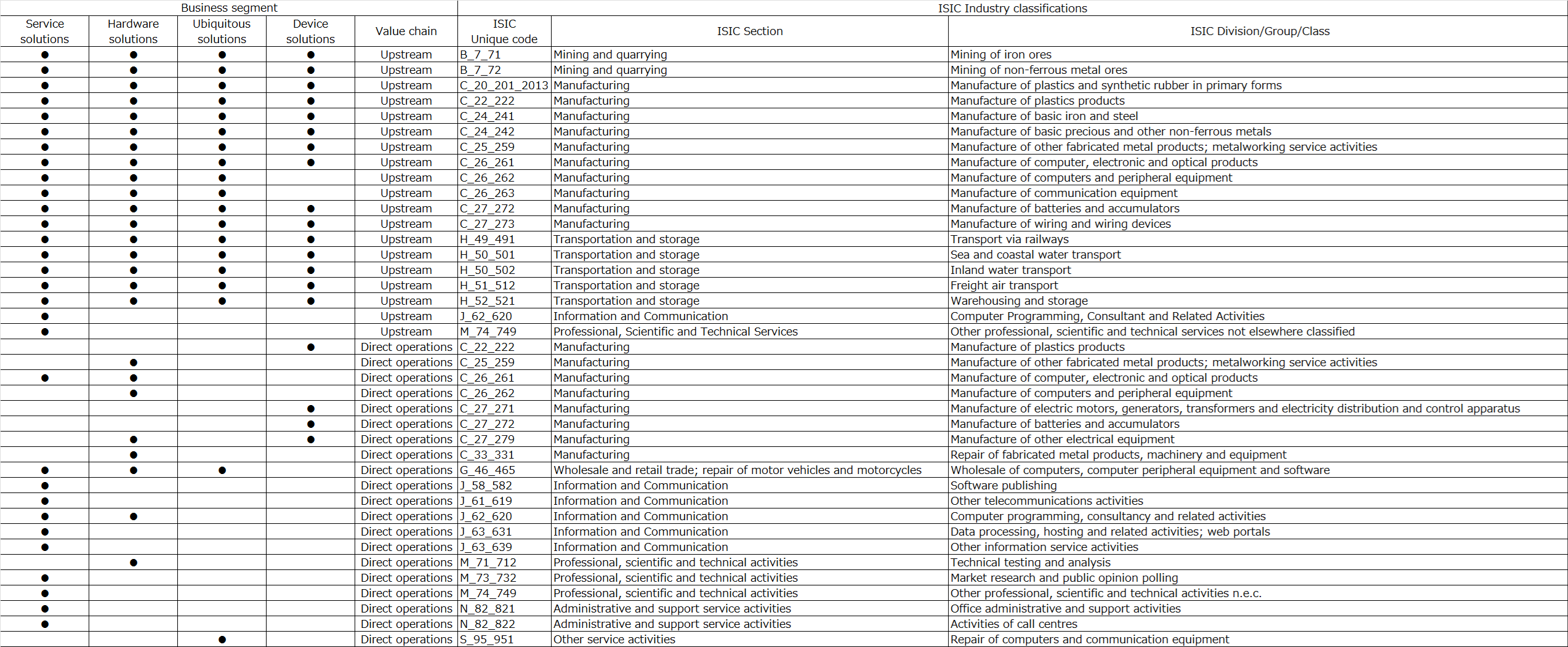
(2)Identification of important dependencies and impacts
The assessment results from ENCORE were visualized as a heat map showing nature-related dependences and impacts on the supply chain and in direct operations. As a result, the emission of pollutants into water and soil might be founded as a highly important impact for consideration in the supply chain and in direct operations.

3.3 Assessment of nature-related risks and opportunities
(1)Overall summary
Taking into account the nature-related dependencies and impacts identified in the Evaluate phase, our own list of nature-related risks and opportunities was created by aggregating ① Examples of TNFD risks and opportunities, ② Disclosure of benchmark companies, and ③ Previously identified risks and opportunities.
A qualitative assessment (three levels of low-medium-high) was conducted on the importance of the listed risks and opportunities, based on two axes of “degree of impact” and “likelihood of occurrence”.
Scenario: A rapid “deterioration in nature-related and ecosystem services”, where “consistency of market and non-market principles” is progressing to integration
• Situation where business must facilitate the start of prompt and organization-based action on sudden and significant natural destruction
• Natural capital including climate change is recognized as a significant issue, that is attracting concern at a point of policy shift
• Rapid encouragement of nature-positive technological investment, to advance with macro-economic changes accelerating action on natural capital
Note that this identification of risks and opportunities and assessment of importance is a first step. More study will be conducted with a view to updated disclosure in FY2026 and beyond.
(2)Main nature-related risks (to be revised in FY2026 or after)
Any decline in the ecosystems that Fujitsu’s supply chain might depend on incurs risks to raw materials procurement, direct operations, and to the supply of products and services. It was also possible to identify the potential for other risks such as increased cost of responding to customers’ changing preferences and corporate reputational damage due to failure to address natural capital.
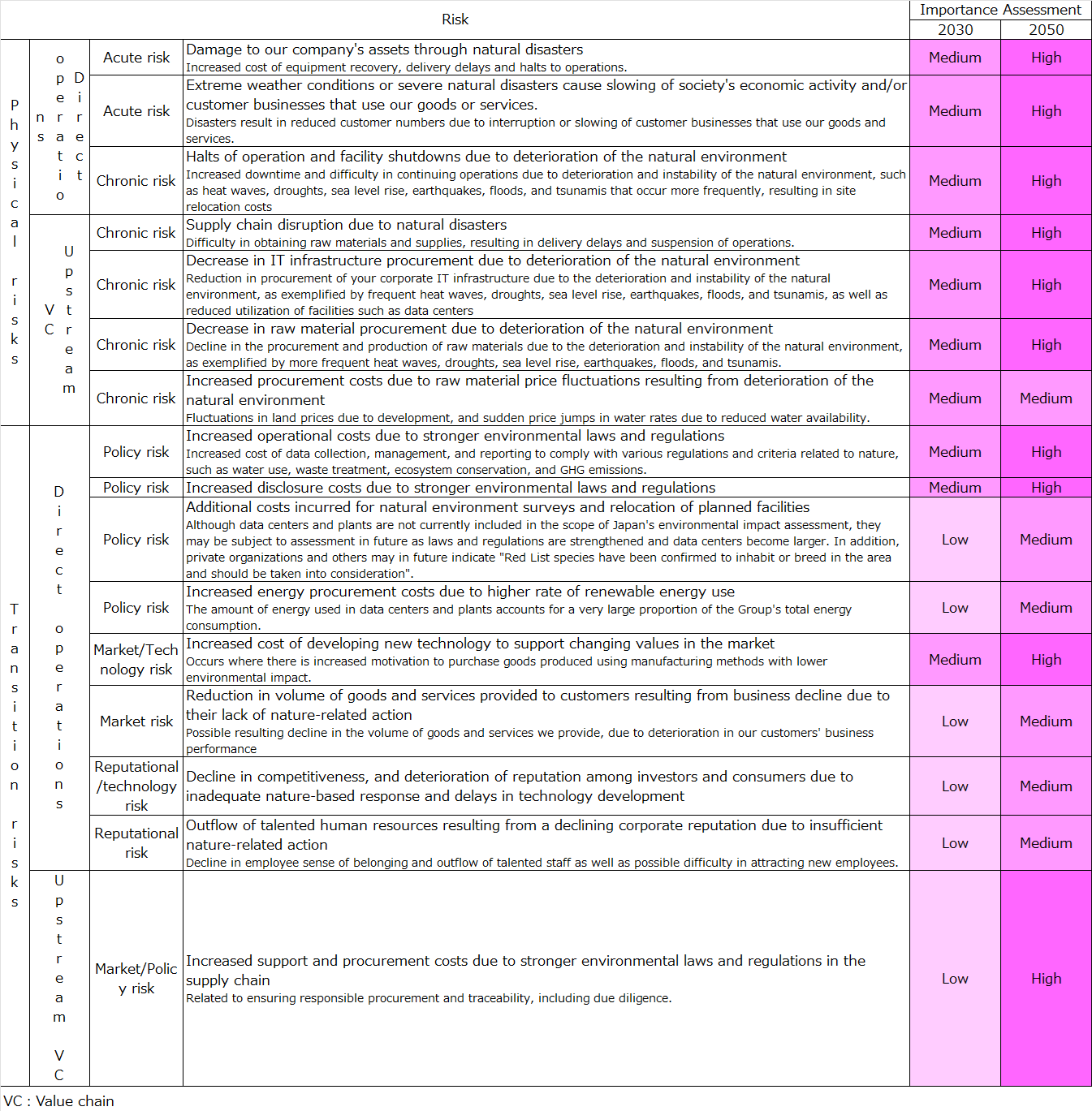
(3)Main nature-related opportunities(to be revised in FY2026 or after)
For Fujitsu, a company with strengths in ICT technology, potential opportunities were identified in the building of sustainable supply chains, and increased demand for corporate services such as use of ICT technology for more efficient ecosystem monitoring and environmental impact measurement.

3.4 Identification of priority locations
(1)Overall summary
A location that is both a “Sensitive location” and a “Material location” is defined as a “Priority location”.
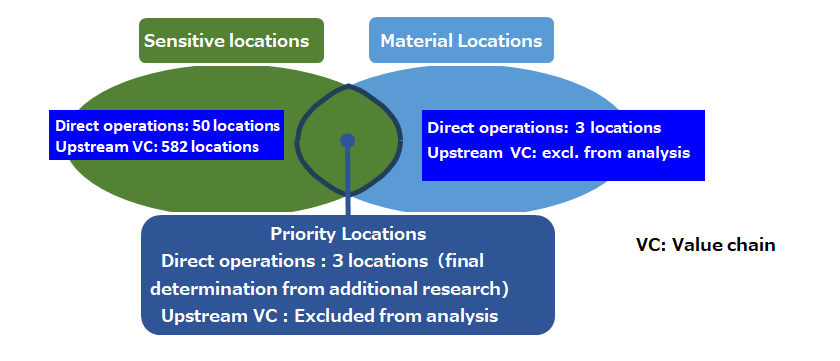
(2)Identification of sensitive locations(to be revised in FY2026 or after)
For direct operations, manufacturing sites, main data centers, main development centers and offices were assessed. For supply chains, extraction sites for ten types of energy and mineral resources were assessed, estimated from trade statistics. The following ten types of energy and mineral resources were selected, with reference to the SBTN High Impact Commodity List, Fujitsu’s product LCA data and procured energy types.
・Coal, natural gas (including liquefied natural gas, compressed natural gas, etc.), petroleum (crude oil)/oil, copper, gold, nickel, silver, zinc, aluminum, steel
The databases used for identification of sensitive locations were selected as shown in the list below, taking into consideration their use as a standard database and availability of tools.
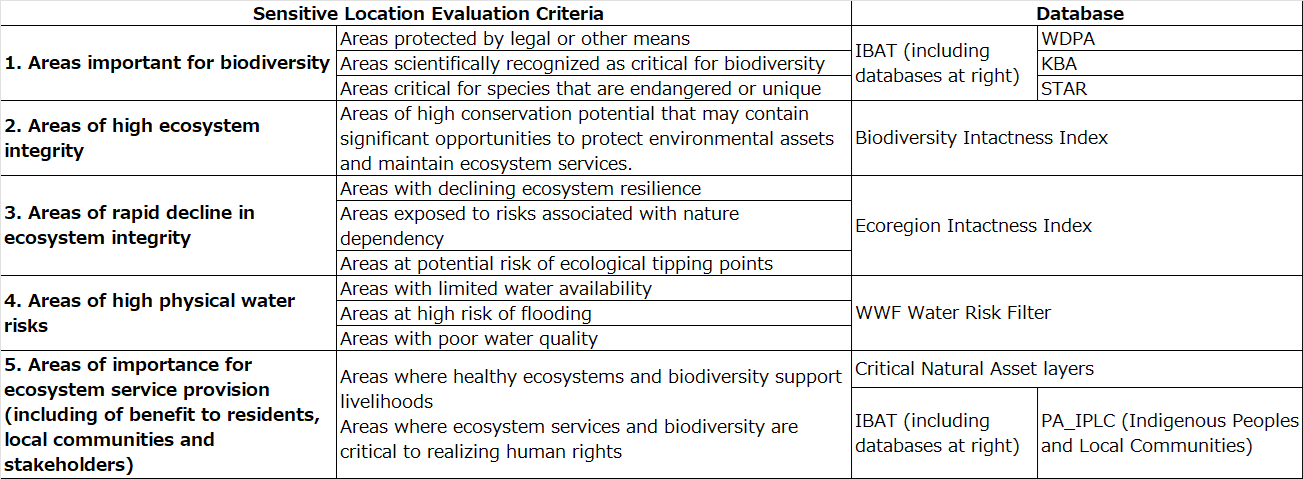
The score criteria thresholds for the metrics that are the criteria for assessment as a sensitive location are shown in the following table. Even one score of 5 on a metric means assessment as a sensitive location.

As a result of assessment of locations according to the scoring criteria above, 632 sites (of 829 sites) were determined to be sensitive locations.
For direct operation sites, 50 of 51 sites fit the sensitive location criteria, mainly due to them being located within 20 kms of a protected area or KBA.
For upstream sites, approximately 30 to 60% of each resource category had protected areas or KBAs within a 20 km radius of the site, with some oil or natural gas fields being BII, ErII, or high physical water stress locations.
The above results are provisional result because the sensitive location scoring criteria are provisional.

(3)Identification of material locations and priority locations
In direct operations, for those locations that might have significant impact on nature (emissions of soil and water pollutants), “Volume of chemical emissions” and “Volume of waste emissions” were checked by linking location information and Evaluate assessment results. Three plants outside Japan were identified as locations that might have negative impact on the surrounding natural environment or important ecosystems. Future analysis will undertake detailed checks on the existence of negative impacts, and assess material locations and priority locations.
Regarding the supply chain, identification of material locations and priority locations were excluded from analysis since the assessment was based on general estimates only.
3.5 Metrics and targets (Comprehensive assessment of all corporate activity)
(1) Alignment with the Kunming-Montreal Global Biodiversity Framework (GBF)
The Fujitsu Group’s vision for 2050 is to “Create a world in harmony with nature, where "nature and biodiversity," which are fundamental to a sustainable society, are fully restored through digital technology”. This aligns with the GBF’s global biodiversity target for 2050, “A World in harmony with nature”.
Further, its 2030 Mid-term Target is to “Reduce negative impacts on biodiversity by at least 25% (Base year : FY2020) in the area of company's corporate activities, including supply chain, and promote activities to increase positive impacts on biodiversity”. This aligns with 2030 International Target 15 of the GBF.
Negative impacts are assessed using Ecological Footprint.
(2)Validity of Ecological Footprint indicator
The Ecological Footprint (EF) is set as a Goal B (Prosper with Nature) Complementary indicator in the monitoring framework adopted by COP16 in 2025. It is highly aligned with GBF.
The Ecological Footprint is recognized as an indicator for scientific measurement of impact on biodiversity. It has also been proposed as a candidate for Target15’s indicator by SBSTTA-24 (Twenty-fourth meeting of the Subsidiary Body on Scientific, Technical and Technological Advice of the Convention on Biological Diversity). It is appropriate as a corporate target as it can assess various types of impacts on biodiversity.
On the other hand, because important nature-related issues vary according to location, for priority locations in the Fujitsu Group, we plan to consider whether monitoring with an additional metric is required according to the status of the business activity and ecosystems at the said location, taking into account the results of the LEAP analysis explained in Strategy.
(3) Assessment results and performance using the Ecological Footprint (EF) indicator
The results of our EF assessment of the Group's corporate activities show that emissions of CO₂ from the Group and its supply chain activities together account for 92% of the negative-impact factors. Water resource utilization accounts for the remaining 8%, but we found that this was mainly attributable to energy use. We established that emissions of CO₂ and energy use together account for 99% of the negative-impact factors. This means that activities aimed at reducing GHG emissions, such as energy conservation and the introduction of renewables, can also reduce the Ecological Footprint. In short, this clearly demonstrates that the Group’s climate change measures are proving effective in reducing negative impacts on biodiversity.
The result of EF assessment in FY2024 was to reduce the negative impact on biodiversity by 28.5% against a baseline of FY2020.
